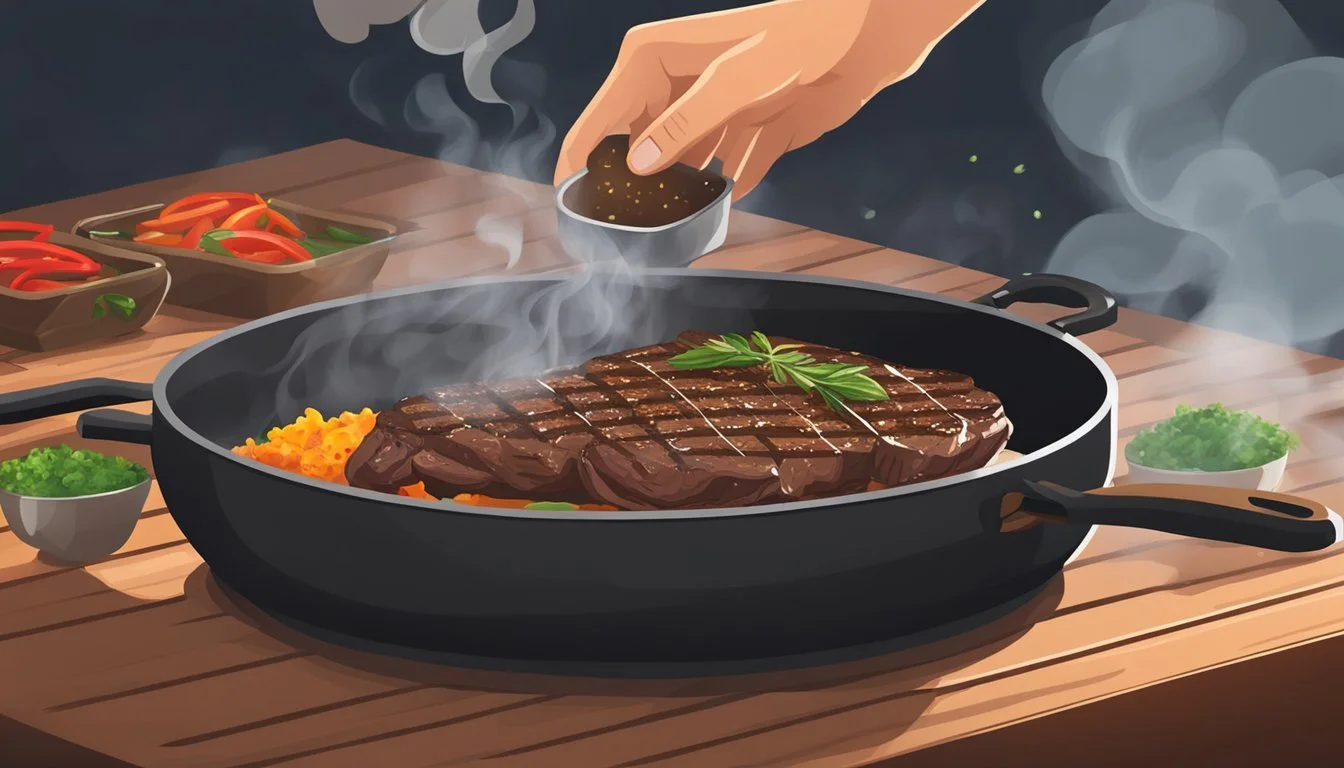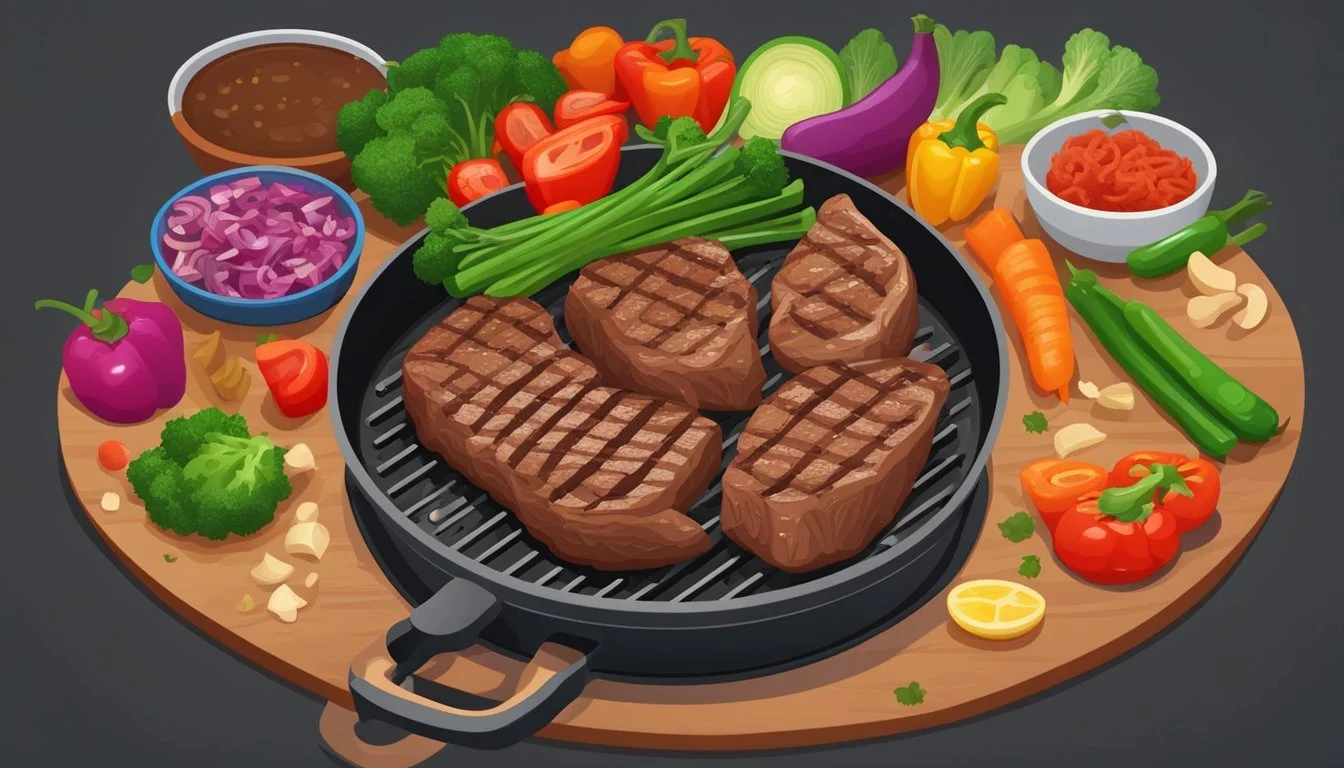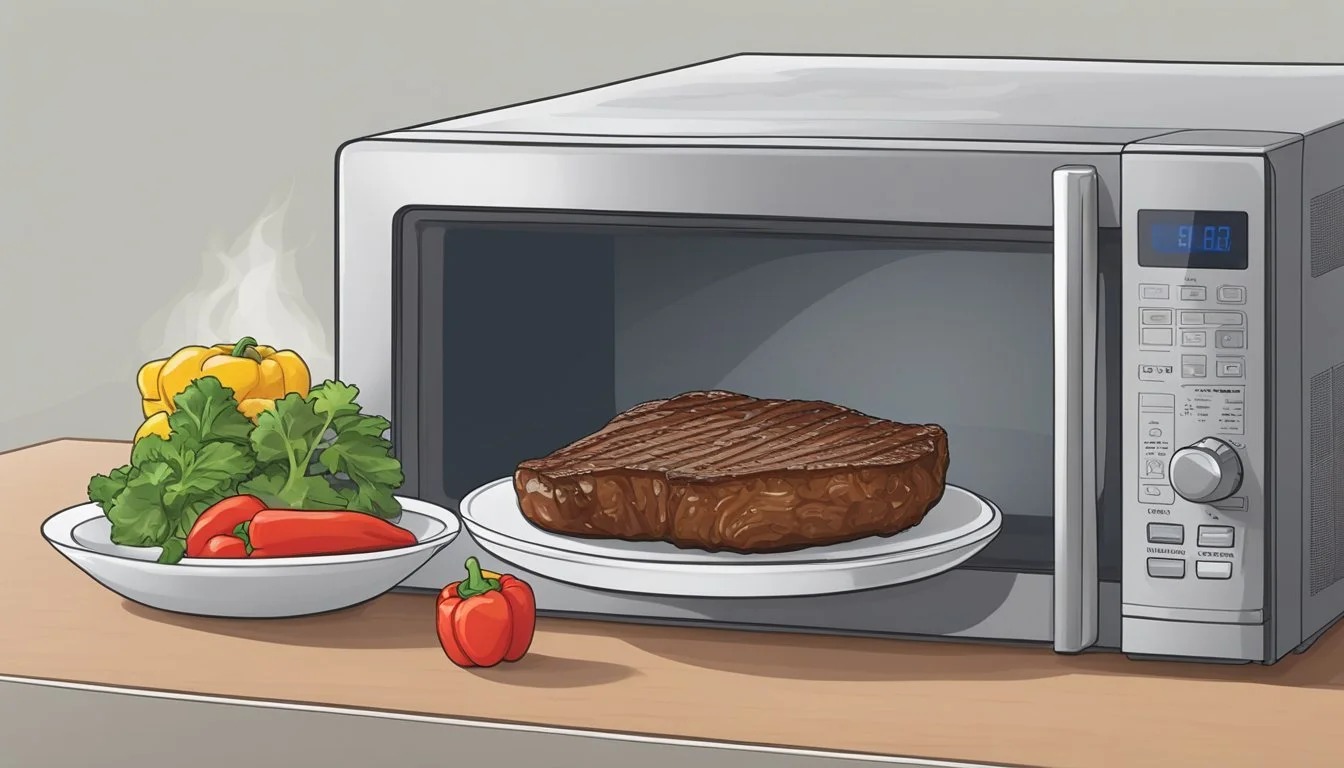How to Eat a Pepper Steak:
A Step-by-Step Guide
Pepper steak is a classic dish combining tender slices of steak with bell peppers (What wine goes well with bell peppers?), onions, and a savory sauce. To eat a pepper steak, diners typically enjoy the dish as a standalone entrée or paired with sides such as rice, noodles, or bread. The combination of meat and vegetables, coated in a thickened sauce of soy, ginger, and garlic, creates a well-rounded flavor profile that is both satisfying and delicious.
Eating pepper steak begins with a fork and knife to cut the steak into manageable bites, blending them with pieces of bell pepper and onion on the fork to enjoy the full spectrum of flavors in one mouthful. Whether in a home kitchen or at a restaurant, the experience is characterized by the rich textures and robust seasoning of the dish, encouraging a moment of indulgence with every bite.
The versatility of pepper steak allows it to cater to varied taste preferences and dietary needs, with optional garnishes like green onions or sesame seeds often added for enhanced flavor and visual appeal. This dish reflects the cultural fusion of Western and Asian cooking techniques, offering a hearty meal that is both comforting and easy to make.
Understanding Pepper Steak
Pepper steak is a savory dish known for its rich sauce and tender cuts of beef (how long does beef last?) paired with the bite of bell pepper and the sweetness of onions. Mastering pepper steak starts with selecting the appropriate beef and ends with a harmonious blend of ingredients that round out its taste and nutritional profile.
Choosing the Right Cut of Beef
The cut of beef is crucial in achieving a pepper steak that's both flavorful and tender. Popular choices include:
Flank steak: prized for its strong beefy flavor and lean quality
Sirloin: balances tenderness with a meaty texture
Skirt steak: known for its deep, rich flavor
Top round steak: affordable yet requires careful cooking to avoid toughness
Tenderness is key in pepper steak, so cuts like flank steak and sirloin are top choices, as they offer both flavor and a softer chew when cooked properly.
Essential Ingredients Overview
A classic pepper steak recipe contains:
Beef: cut into thin strips
Peppers: green and red bell peppers, sliced
Onion: adds sweetness
Garlic: for aromatic depth
Soy sauce: brings a salty, umami richness
Cornstarch: thickens the sauce for a glossy finish
Sugar: just a hint to balance the sauce
Vegetables: typically bell peppers and onion
Additional ingredients can include ginger, sesame seeds, oyster sauce, and Shaoxing wine to elevate the dish further.
Nutritional Information
Nutritionally, pepper steak can be quite balanced. Here’s a brief nutritional overview:
Protein: Beef is a rich source of protein, essential for muscle repair and growth.
Fat: Depending on the cut of beef, fat content will vary. Leaner cuts have less fat.
Sodium: Soy sauce contains sodium, so low sodium options are available for those watching their intake.
Nutrient Approximate Value per Serving Calories 350-450 Protein 25-35g Fat 10-20g Carbohydrates 15-25g Sodium Varies (can be adjusted)
For individuals who are health-conscious, adjustments can be made to the recipe, such as using low sodium soy sauce and leaner cuts of beef like sirloin or flank to reduce fat content.
Preparation Techniques
Pepper steak, with its tender slices of beef, vibrant peppers, and savory sauce is a delightful dish that requires thoughtful preparation. Mastering the cooking process will result in an exquisite stir-fry that's both flavorful and appealing to the palate.
Meat Preparation
Beef Selection: Choose a lean cut like flank steak or sirloin and slice the meat against the grain into thin strips, about 4-5mm thick. This ensures tenderness and quick cooking. If the meat is slightly frozen, it will be easier to cut cleanly.
Marinating: Create a mixture of soy sauce, garlic, and other seasonings to marinate the beef. The meat should be fully coated and allowed to sit for at least 30 minutes to absorb the flavors.
The Velveting Process
Ingredients: Cornstarch, egg whites, oil, water, oyster sauce, and Shaoxing wine are common velveting ingredients. Method: Mix these ingredients with the beef to coat it lightly. This process protects the meat during cooking, resulting in a silky texture.
Efficient Cooking Strategies
Equipment Choice: Whether using a wok or a large skillet, ensure it is well-heated before starting to cook. Oils with high smoking points like vegetable or canola oil are preferred.
Cooking Method: Sear the beef in batches if necessary to keep the skillet from crowding, which ensures each piece is evenly cooked and maintains a rich flavor.
Cutting and Handling Vegetables
Vegetable Prep: Bell peppers, onions, carrots, and mushrooms should be cut uniformly for even cooking. Cooking Order: Sauté tougher vegetables like carrots a bit longer before adding quick-cooking vegetables like bell peppers.
Creating the Pepper Steak Sauce
Sauce Components: Combine soy sauce, beef broth, sugar, ginger, and cornstarch. The cornstarch will help thicken the sauce during cooking. Adjustments: Taste the sauce before adding it to the stir-fry and adjust seasonings as needed.
Stir-Fry Cooking Instruction
Heat Management: Keep the heat at medium-high throughout the cooking process for a proper stir-fry effect. Final Steps: Once the meat and vegetables are cooked, pour the sauce into the skillet and stir continuously until the sauce thickens and coats the ingredients.
Cooking and Assembly
Crafting the ideal pepper steak involves precision cooking of the beef and a harmonious blend of vegetables and sauce to ensure a flavorful experience.
Cooking the Beef to Perfection
The beef, whether it's sirloin, skirt steak, or round steak, must be cut into strips, ensuring they are of even thickness for uniform cooking. To tenderize and keep the meat juicy, a combination of cornstarch, oil, and possibly baking soda is used in a process known as 'velveting' the beef. The meat strips are then quickly browned over high heat to seal in flavors.
Combining Meat and Vegetables
Once the beef is browned, the next step is to introduce vegetables like green bell pepper and red bell pepper, and onions into the pan. Some recipes suggest cooking them separately to maintain their crispness and then combining them with the meat. The peppers and onions should be cooked until just tender, ensuring they don't lose their crunch.
Finalizing the Dish
The final stage of assembly involves mixing the beef and vegetables with the sauce which typically consists of ingredients like broccoli, soy sauce, and brown sugar, depending on the recipe. The mixture is then left to simmer, which allows the flavors to meld. To complete the dish, it is commonly served over cooked rice or as part of a stir-fry. The resulting dish should offer a balance of tender meat and crisp vegetables, all coated in a rich, savory sauce.
Serving Suggestions
Pepper steak, a hearty dish with robust flavors, is best enjoyed with sides and beverages that complement its taste and presentation. A well-rounded meal includes a balance of textures and nutrients, while visual appeal heightens the dining experience.
Accompaniments and Sides
Rice Varieties:
White Rice: Serves as a blank canvas, absorbing the rich sauce of pepper steak.
Cauliflower Rice: A low-carb alternative that pairs well with the savory flavors.
Noodles:
Pair pepper steak with chow mein for an Asian-inspired twist.
Vegetables:
Broccoli and Asparagus: Provide a crunchy contrast to the tender steak.
Steamed Baby Corn and Snap Peas: Add sweetness and variety to the plate.
Garnishes:
Sesame Seeds: Lend a subtle, nutty crunch as a finishing touch.
Chopped Green Onions: Offer a pop of color and a mild, oniony bite.
Presentation Tips
Plating: Serve pepper steak atop rice or beside noodles to ensure a balance of flavors with each forkful.
Garnish: Sprinkle sesame seeds and finely sliced green onions over the dish for visual interest and added flavor.
Pairing with Beverages
Wine:
A robust red wine such as a Cabernet Sauvignon complements the bold flavors of the steak.
Beer:
A malty lager can counterbalance the spice and cleanse the palate.
Storage and Reheating
Proper storage and reheating techniques are crucial for enjoying leftover pepper steak while maintaining its flavor and texture. This section offers guidance on how to store leftovers safely and how to best reheat them to achieve a taste that's as close as possible to when it was freshly cooked.
Storing Leftovers
Leftover pepper steak should be stored in the refrigerator within two hours of cooking to prevent bacterial growth. It can be kept in an airtight container for up to 3-4 days. For longer storage, freezing is an option. When freezing, use a freezer-safe container or a heavy-duty freezer bag, eliminating as much air as possible before sealing to prevent freezer burn. Pepper steak can be stored in the freezer for up to 3 months.
Reheat for Optimal Taste
When reheating, the goal is to warm the pepper steak thoroughly while preserving its moisture and flavor. The oven or stovetop is generally preferred over the microwave for better results.
Oven:
Preheat the oven to 300 degrees Fahrenheit.
Place the steak on a wire rack in a rimmed baking sheet to allow air circulation.
Reheat until the internal temperature reaches 165 degrees Fahrenheit for safety, usually for about 10-15 minutes.
Stovetop:
Warm a skillet over medium heat and add a bit of beef broth or water to avoid drying out.
Once hot, add the steak and heat through, turning once, for about 2-3 minutes per side.
Using a microwave can be faster though less ideal:
Set the microwave to medium power.
Reheat in 30-second intervals, flipping in between, until heated through, which generally takes about 1-2 minutes total.
All reheating methods should ensure the steak reaches a safe internal temperature as mentioned.
Alternative Approaches
Exploring different methods of preparing and serving pepper steak can lead to delicious variations that satisfy a range of dietary preferences and spice tolerances.
Variations of Pepper Steak
One can experiment with the classic pepper steak recipe by introducing additional ingredients or flavors. Here are a few ideas:
Sauce Variations: Incorporate honey or rice vinegar to add a sweet or tangy profile to the sauce.
Heat Adjustments: To alter the spice level, one might add sriracha for extra heat or red pepper flakes for a milder but still flavorful kick.
Protein Variations: While beef is traditional, one can easily swap in chicken or tofu as the protein base for a different take.
Substitution Ideas
Substituting ingredients can transform the standard pepper steak into a unique dish while also catering to what's available or preferred. Consider the following switches:
Pepper Varieties: Mix and match with green and red bell peppers or even add yellow and orange for a colorful twist.
Oil Choices: Replace vegetable oil with alternatives like olive or avocado oil for a change in the nutritional profile.
Starch Substitutes: Instead of serving with rice, one might try quinoa, cauliflower rice, or noodles to pair with the savory steak.
Adapting for Dietary Restrictions
Pepper steak can be adjusted to respect various dietary requirements without sacrificing flavor:
Low Sodium Options: Opt for low sodium soy sauce and broth to decrease the overall salt content.
Gluten-Free Needs: Utilize gluten-free tamari or soy sauce to make the dish safe for those with gluten sensitivities.
Vegetarian Adaptations: Substitute beef with tofu or seitan (What wine goes well with seitan?) and ensure the use of vegetable broth to keep the meal vegetarian-friendly.






